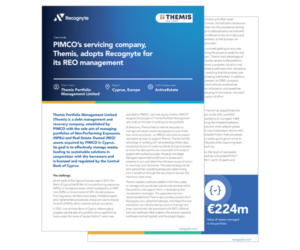26 Jan 2023
Its goal is to effectively manage assets, leading to sustainable solutions in cooperation with the borrowers and is licensed and regulated by the Central Bank of Cyprus.
The challenge
At the peak of the Cyprus financial crisis in 2013, the Bank of Cyprus had €14bn of non-performing exposures (NPEs) on its balance sheet, which translated to an NPE ratio (NPEs to Gross Loans) of 52%. Amidst pressure from regulators, the Bank took steps, initiated projects and implemented procedures whose aim was to reduce its stock of NPEs whilst maximizing loan recoveries.
In 2021, one of these Bank of Cyprus’ deleveraging projects was the sale of a portfolio of non-performing loans under the name of ‘project Helix 2’ which was awarded to PIMCO, a private equity investor. PIMCO assigned the project to Themis Portfolio Management who took on the task of working out the portfolio.
At that time, Themis had no internal resources to manage real estate assets repossessed as part of the loan workout process, so PIMCO instructed an expert real estate servicer to support Themis. Themis had the advantage of working with remediated portfolio data completed as part of a previous Bank of Cyprus project, so knew the data quality was reasonable and ready to support the workout process. However, the Asset Managers appointed would have to assess each property in turn and determine the best course of action to maximize loan recoveries. This asset strategy would form part of their overall business plan determining how it would run through the securities to recover the maximum asset value.
Themis needed a software platform from the outset to manage and coordinate operational activities within the portfolio and support them in developing their monetization strategies. The appointed servicer recommended that Themis use a turnkey solution from Recognyte, now called ActiveEstate, that helps financial institutions use industry best practice to manage and lower operational risks associated with REO collateral and loan workouts. After a demo, the solution was sold, a software contract signed, and the project began.
The solution
The portfolio, worth almost € 1.4bn, contained 38,224 loans secured by 9,614 real estate collateral. Dealing with this volume of granular assets, the company wanted to oversee the real estate lifecycle efficiently to achieve the highest recoveries. A target number was set for Themis to achieve in monetising these assets in the eighteen-month period. Themis began by onboarding the assets into ActiveEstate, storing all asset information, including any income and costs alongside each asset. The work began, and each property was evaluated for how the debt would be resolved.
Themis were in a good position to lead in the negotiations with borrowers as the team had all the relevant details of the properties securing each loan at its fingertips which gave it an upper hand in achieving the best outcome. In an ideal scenario, a cash settlement figure would be quickly agreed with the borrower with the asset released to the borrower. Alternatively, by consensual arrangement with the borrower, the asset would be repossessed by Themis with either a partial or full write-off of the debt – a process known as a ‘debt for asset swap’. In cases where delinquent borrowers were refusing to cooperate, this would trigger the foreclosure process in the system and initiate a repossession of the property. A small number of those assets sold at auction, but the majority transferred ownership to Themis who were guided by the REO workstream process within ActiveEstate.
Real estate owners and Asset Managers needed to take care of any property maintenance as well as any value-add activity that could give the property more value and liquidity. This would typically involve reviewing and resolving issues with leases, evicting tenants, negotiating contracts and other asset management related activities. ActiveEstate introduced efficiency and effectiveness into this process by storing reliable, accurate and up-to-date property records with those who needed it and offered timely reminders and notifications to team members, so the process ran smoothly, and according to plan.
Lastly, the REO process involved getting an accurate valuation figure and making the property ready for sale by the in-house sales team. Themis took advantage of the ability to invite third-party valuers to the platform, who were notified whenever a property valuation was required. These third parties could input their valuations directly into the system, ensuring that the process was efficient without any task being overlooked. In addition, a two-way integration between its CRM / property marketing platform and ActiveEstate enabled the seamless sharing of asset information and saved the need for unnecessary rekeying of information into each system, saving on duplication of effort.
The outcome
Through ActiveEstate, Themis has streamlined the end-to-end management of the NPL and REO portfolio and had onboarded and managed 1,464 assets worth €224m during the limited timeframe, meeting their target objective while adopting best practice guidelines that maximized asset returns with minimum effort. It developed friction-free processes and used the solution to apply good governance to a complex real estate lifecycle while improving team collaboration and productivity.
At the end of the project, the team of real estate professionals had successfully onboarded €142m1 of assets, managed €224m1 worth of assets and sold €50m.
